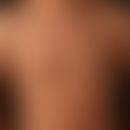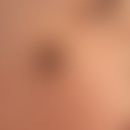Synonym(s)
DefinitionThis section has been translated automatically.
The very rare, non-snydromal, autosomal recessive inherited anonychia (NDNC4) is defined as the absence of fingernails and toenails. Congenital anonychia and its milder phenotypic variant, congenital hyponychia, usually occur as a feature of genetic syndromes associated with significant skeletal and limb abnormalities. An isolated non-syndromal congenital anonychia / hyponychia is a rare entity that usually follows autosomal recessive inheritance with variable expression.
EtiopathogenesisThis section has been translated automatically.
This genodermatosis is caused by mutations in the RSPO4 gene (gene locus 20p13) (Blaydon DC et al. 2006), which encodes R-sponin, a protein that activates the Wnt/beta-catenin signaling pathway (Bergmann C et al. 2006).
You might also be interested in
ClinicThis section has been translated automatically.
The observed nail phenotypes range from complete absence of the nail organ to varying degrees of hypoplasia of the nails(hyponychia).
Case report(s)This section has been translated automatically.
Littman and Levin (1964) reported on a 66-year-old woman who suffered from a congenital absence of 7 fingernails without other abnormalities. Her nails were normal on the thumbs and left fifth finger, but were absent on the other fingers, which the patient reported to have rudimentary matrices and nothing resembling nails ever present. Her toenails were normal. Phalanges and patellas could be palpated normally, and bony structures of the thorax, spine, and pelvis were normal on radiography. A 60-year-old brother who lived in eastern Germany reportedly had 8 fingernails with nail beds similar to those of the proband and normal thumb and toe nails. There were 19 other unaffected family members, including their parents, suggesting autosomal recessive inheritance.
Mahloudji and Amidi (1971) described a consanguineous Iranian pedigree in which 7 affected individuals had absence of all finger and toe nails over 3 generations. The 2 affected family members studied had normal hair, teeth, and bones with no other abnormalities. Normal parents, occurrence in males and females, and frequent consanguinity suggested autosomal recessive inheritance.
Hopsu-Havu and Jansen (1973) reported on a Finnish family in which 4 of 10 children had no finger or toe nails since birth. Examination of the 42-year-old female subject revealed that the nail bed was present on all fingers and toes, but no true nails were present; a rudimentary brittle nail plate was evident on only two fingers. The subject was one of two fraternal twins; her twin sister had normal nails. Hair, teeth, and bones were normal in the affected siblings; the family members had no other abnormalities. The family had lived on an isolated small island off the coast of Finland for hundreds of years.
LiteratureThis section has been translated automatically.
- Al Hawsawi K et al (2002) Anonychia congenita totalis: a case report and review of the literature. Int J Derm 41: 397-399.
- Bergmann C etn al (2006) Mutations in the gene encoding the Wnt-signaling component R-spondin 4 (RSPO4) cause autosomal recessive anonychia. Am J Hum Genet 79: 1105-1109.
- Blaydon DC et al (2006) The gene encoding R-spondin 4 (RSPO4), a secreted protein implicated in Wnt signaling, is mutated in inherited anonychia. Nature Genet. 38: 1245-1247.
- Bruchle NO et al. (2008) RSPO4 is the major gene in autosomal-recessive anonychia and mutations cluster in the furin-like cysteine-rich domains of the Wnt signaling ligand R-spondin 4. J Invest Derm 128: 791-796.
- Bergmann C et al (2006) Mutations in the gene encoding the Wnt-signaling component R-spondin 4 (RSPO4) cause autosomal recessive anonychia. Am J Hum Genet 79:1105-1109.
- Blaydon DC et al (2006) The gene encoding R-spondin 4 (RSPO4), a secreted protein implicated in Wnt signaling, is mutated in inherited anonychia. Nat Genet 38:1245-1247.
- Brüchle NO et al. (2008) RSPO4 is the major gene in autosomal-recessive anonychia and mutations cluster in the furin-like cysteine-rich domains of the Wnt signaling ligand R-spondin 4. J Invest Dermatol 128:791-796.
- Chisti MS et al (2008) A novel missense mutation in RSPO4 gene underlies autosomal recessive congenital anonychia in a consanguineous Pakistani family. Brit J Derm 158: 621-623.
- Hopsu-Havu VK et al (1973) Anonychia congenita. Arch Derm 107: 752-753.
- Ishii Y et al (2008) Mutations in R-spondin 4 (RSPO4) underlieinherited anonychia. J Invest Dermatol 128:867-870.
- Littman A et al (1964) Anonychia as a recessive autosomal trait in man. J Invest Derm 42: 177-178.
- Mahloudji M et al. 1971) Simple anonychia: further evidence for autosomal recessive inheritance. J Med Genet 8: 478-480.
- Ozdemir O et al (2004) Total anonychia congenita: a rare heterogeneic disorder. Genet. Counsel15: 43-46.
- Timmer J et al (1969) Anonychia congenita totalis van vingers en tensen. Nederl T Geneesk 113: 395-397.
Incoming links (3)
Genetically caused non-syndromal nail abnormalities; Nail disorder, nonsyndromic congenital 1-10; RSPO4 Gene;Outgoing links (1)
RSPO4 Gene;Disclaimer
Please ask your physician for a reliable diagnosis. This website is only meant as a reference.




